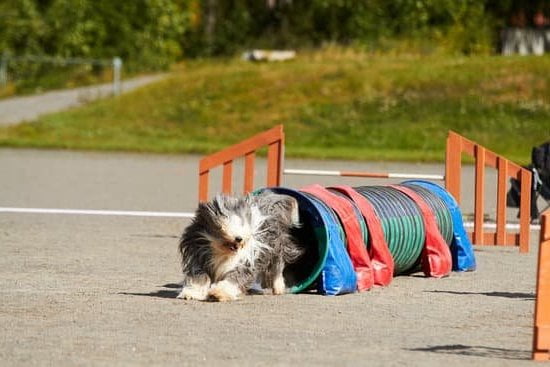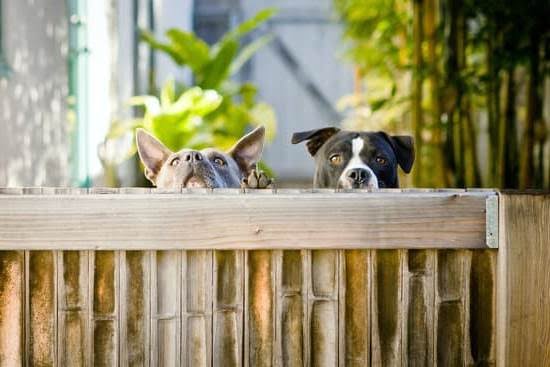Potty training a 3-year-old male dog can be challenging, but with the right strategies and techniques, it is definitely achievable. Understanding the importance of potty training for adult male dogs is crucial in maintaining a clean and harmonious living environment for both you and your furry companion.
In this article, we will delve into the specific signs that indicate your 3-year-old male dog needs potty training, as well as provide expert advice on setting up a consistent potty training schedule.
As a pet owner, recognizing the signals that your 3-year-old male dog requires potty training is essential. Whether it’s frequent accidents indoors or restless behavior when needing to relieve themselves, these signs shouldn’t be ignored. By understanding your dog’s behavior and setting up a structured routine, you can effectively address their needs and guide them towards successful potty training.
Establishing a consistent potty training schedule is key to helping your 3-year-old male dog form good habits. By choosing the right potty spot for your furry friend and implementing positive reinforcement techniques, you can make the training process more enjoyable for both of you. Additionally, knowing how to react and clean up effectively in case of accidents will help reinforce good behavior and prevent setbacks in your potty training journey.
Signs That Your 3 Year Old Male Dog Needs Potty Training
Potty training a 3-year-old male dog can be challenging, but with patience and consistency, it can be accomplished successfully. One of the first signs that indicate your dog needs potty training is if they have accidents in the house frequently.
If you notice your dog relieving himself indoors or having trouble holding his bladder for extended periods, it’s time to start potty training. Additionally, if your dog sniffs around excessively, paces back and forth, or whines before eliminating, these are all signs that he needs proper potty training.
To begin the potty training process for your 3-year-old male dog, establish a consistent schedule for feeding and bathroom breaks. Take your dog outside to the designated potty spot after meals, upon waking up in the morning, before bedtime, and every few hours throughout the day. By maintaining a routine, you will help your dog understand when it’s time to go potty outside. Consistency is key in reinforcing good habits and preventing accidents indoors.
Positive reinforcement is a powerful tool in potty training older dogs. When your 3-year-old male dog eliminates in the appropriate outdoor location, praise him enthusiastically and offer treats as a reward. Dogs respond well to positive feedback and will quickly learn that going potty outside leads to positive outcomes.
Avoid scolding or punishing your dog for accidents inside the house as this can create anxiety and hinder the potty training progress. With patience and consistency, you can effectively train your adult male dog to become fully potty trained.
| Signs Your Dog Needs Potty Training | How to Respond |
|---|---|
| Frequent accidents indoors | Start setting up a consistent schedule for bathroom breaks. |
| Excessive sniffing or whining before eliminating | Establish positive reinforcement techniques for successful potty training. |
Setting Up a Consistent Potty Training Schedule
Consistency is key when it comes to potty training a 3-year-old male dog. Establishing a regular schedule for bathroom breaks can help your furry friend understand when and where they should eliminate. Make sure to take your dog out first thing in the morning, after meals, before bedtime, and at regular intervals throughout the day. By maintaining a consistent routine, you are setting your dog up for success in learning how to control their bladder.
To effectively potty train a 3-year-old male dog, it’s essential to pay attention to their body language and behavior. Keep an eye out for signs such as sniffing around, circling, or whining, as these may indicate that your dog needs to go outside. By being observant and proactive in taking your dog out during these times, you can prevent accidents indoors and reinforce positive potty habits.
Additionally, consider using verbal cues or commands when taking your dog outside to go potty. This can help them associate specific words with the action of eliminating. For example, saying “go potty” or “do your business” every time you take them outside can help communicate what is expected of them. With patience, consistency, and proper reinforcement techniques, you’ll be well on your way to successfully potty training your 3-year-old male dog.
| Key Points | Details |
|---|---|
| Consistent Schedule | Establish regular bathroom breaks throughout the day. |
| Body Language | Look for signs like circling or whining indicating the need to go outside. |
| Verbal Cues | Use specific commands like “go potty” while training. |
Choosing the Right Potty Spot for Your Dog
When it comes to potty training a 3 year old male dog, choosing the right potty spot is crucial for success. The location where your dog goes potty can greatly impact the training process and help establish good habits. Here are some key considerations for selecting the perfect potty spot for your furry friend.
Outdoor vs. Indoor Potty Spot
Deciding whether your dog will have an outdoor or indoor potty spot is the first step in choosing the right location. If you prefer outdoor potty training, make sure to designate a specific area in your yard or garden for this purpose. For indoor training, consider using pee pads or a designated litter box in a consistent spot within your home.
Accessibility and Convenience
The chosen potty spot should be easily accessible to your dog at all times. This means it should be close enough for them to reach quickly when needed. Additionally, ensure that the spot is convenient for you as well, making it easier to supervise and clean up after your pet.
Odor Control and Maintenance
When selecting a potty spot, consider how easy it will be to maintain cleanliness and control odors. Choose an area that is away from high-traffic areas of your home or yard, and one that can be easily cleaned regularly. Using odor-neutralizing products can also help keep the designated spot fresh and appealing for your dog’s potty needs.
By carefully choosing and preparing the right potty spot for your 3 year old male dog, you can create a conducive environment for successful potty training. Remember to provide positive reinforcement when your pet uses the designated area correctly, helping them establish good habits over time. With patience and consistency, you’ll soon see progress in your furry friend’s potty training journey.
Positive Reinforcement Techniques for Potty Training Success
Potty training a 3-year-old male dog requires patience, consistency, and positive reinforcement techniques. Here are some helpful tips to ensure success in teaching your furry friend where and when to go potty:
- Use treats: Positive reinforcement is key when it comes to potty training. Whenever your dog goes potty in the designated spot, immediately reward him with his favorite treat. This will help him associate going to the bathroom in the right place with receiving a reward.
- Use verbal praise: In addition to treats, make sure to shower your dog with verbal praise every time he successfully goes potty outside or in the designated area. Use a happy and enthusiastic tone to let him know he did a great job.
- Establish a routine: Dogs thrive on routine, so make sure to take your 3-year-old male dog out for potty breaks at consistent times throughout the day. This will help him learn when it’s time to go and reduce the likelihood of accidents inside the house.
Remember that every dog is different, so it’s important to figure out what motivates your furry companion during potty training. Stay patient, stay consistent, and be generous with rewards and praise whenever he gets it right. With time and dedication, you’ll have your 3-year-old male dog fully potty trained in no time.
Dealing With Accidents
Reacting to Accidents
Accidents are a normal part of the potty training process, especially when training a 3-year-old male dog who may have established habits. It’s important to remain calm and avoid scolding your dog when accidents happen. Punishing or yelling at your furry friend can create fear and confusion, making it harder for them to understand the desired behavior. Instead, quietly clean up the mess and continue with the training process.
Cleaning Up Effectively
When accidents occur, it’s crucial to thoroughly clean up the area to remove any lingering odors that may attract your dog back to the same spot. Use a pet-safe cleaner specifically designed for removing pet stains and odors. Avoid cleaners with ammonia as they can mimic the scent of urine, potentially encouraging your dog to repeat the accident in that spot.
Reinforcing Positive Behavior
After cleaning up an accident, focus on reinforcing positive behavior by praising and rewarding your dog when they successfully go potty in the designated spot. This positive reinforcement helps your furry companion understand what behavior is desirable and encourages them to continue using their designated potty area. Consistency in rewarding good behavior is key to successful potty training with a 3-year-old male dog.
By maintaining patience, consistency, and using positive reinforcement techniques, you can effectively handle accidents during the potty training process with your adult male dog. Remember that accidents are a natural part of the learning curve and should be addressed calmly and without punishment. With time and dedication, your furry friend will learn proper potty habits and become fully trained.
Common Mistakes to Avoid During Potty Training
One of the most common mistakes that dog owners make during potty training is inconsistency. Dogs thrive on routine, so it’s crucial to establish a consistent potty training schedule and stick to it.
This means taking your 3-year-old male dog outside to his designated potty spot at the same times every day, such as first thing in the morning, after meals, and before bedtime. By being consistent, you can help reinforce good potty habits in your furry friend.
Another mistake to avoid is punishing your dog for accidents. While it may be frustrating when your dog has an accident inside the house, punishment will only confuse and scare them. Instead, focus on positive reinforcement techniques when they go potty in the right spot. Use treats, praise, and even playtime as rewards for good behavior. This will not only encourage them to continue using their designated potty area but also strengthen your bond with them.
Additionally, overlooking health issues can be a major mistake during the potty training process. If your 3-year-old male dog is having frequent accidents or struggling to hold their bladder, it’s important to rule out any underlying medical conditions that could be causing these issues.
Schedule a visit with your veterinarian to ensure that there are no health concerns affecting your dog’s ability to control their bathroom habits. By addressing any potential health issues promptly, you can set your furry companion up for success in their potty training journey.
- Be consistent with your potty training schedule
- Avoid punishing your dog for accidents
- Address potential health issues promptly
Celebrating Progress and Gradual Independence
Potty training a 3-year-old male dog can be challenging but rewarding. As your dog progresses through the training process, it is essential to celebrate small victories and acknowledge signs of gradual independence. One key indicator that your dog is fully potty trained is when they consistently go to their designated potty spot without any reminders or supervision.
To know if your 3-year-old male dog is fully potty trained, observe their behavior closely. If they consistently signal when they need to go outside or use the bathroom in the designated spot without accidents, they are on the right track. Another sign of successful potty training is when your dog can hold their bladder for longer periods and show understanding of proper bathroom etiquette.
It is important to continue reinforcing positive behaviors even after your dog is fully potty trained. Rewarding them with treats, praise, or playtime every time they exhibit good potty habits will help maintain their good behavior. Additionally, keeping a consistent schedule for feeding and bathroom breaks will help prevent any setbacks in their potty training progress. Remember, patience and consistency are key when teaching a 3-year-old male dog how to potty train effectively.
Final Tips and Tricks for Maintaining Good Potty Habits in Adult Male Dogs
Potty training a 3-year-old male dog may seem like a daunting task, but with patience, consistency, and the right techniques, you can successfully teach your furry friend good potty habits. One of the key factors in successful potty training is understanding the importance of consistency in your approach. By setting up a regular potty schedule for your dog and sticking to it, you will help him develop a routine and learn when and where he should go.
Choosing the right potty spot for your dog is also crucial in the potty training process. Make sure to select an area that is easily accessible to your dog, preferably outdoors where he can relieve himself without any distractions.
Positive reinforcement techniques such as rewards, praise, and treats play a significant role in encouraging good behavior during potty training. By rewarding your dog whenever he goes potty in the designated spot, you are reinforcing this positive behavior and motivating him to continue doing so.
Dealing with accidents is inevitable during the potty training process, but it’s essential to react calmly and clean up effectively to avoid reinforcing negative behaviors. Remain patient and consistent in your approach, focusing on teaching your dog the correct behavior rather than punishing him for mistakes.
Remember that every dog learns at their own pace, so be patient with your furry companion as he progresses through his potty training journey. In no time, with dedication and persistence, you will have successfully potty trained your 3-year-old male dog.
Frequently Asked Questions
Can You Still Potty Train a 3 Year Old Dog?
Potty training a 3-year-old dog is definitely possible, although it may require more patience and consistency compared to training a younger puppy. Using positive reinforcement, frequent bathroom breaks, and a consistent schedule can help make the process successful.
Is It Normal for a 3 Year Old Boy to Not Be Potty Trained?
It is not uncommon for a 3-year-old boy to still be working on potty training. Every child develops at their own pace, and some boys may take longer to master this skill. It’s important to be patient, supportive, and consistent in the approach.
How Do You Potty Train a 3 Year Old Boy That Refuses?
Potty training a 3-year-old boy who refuses can be challenging but persistence is key. Encouraging him to use the potty through positive reinforcement, setting a routine, offering rewards for success, and staying calm through accidents can help in overcoming resistance. Remember that every child is different and progress may take time.

Welcome to the blog! I am a professional dog trainer and have been working with dogs for many years. In this blog, I will be discussing various topics related to dog training, including tips, tricks, and advice. I hope you find this information helpful and informative. Thanks for reading!





